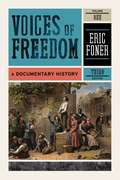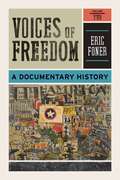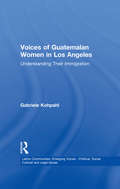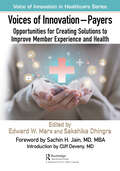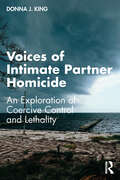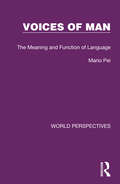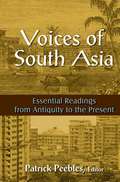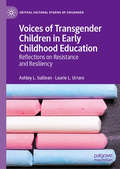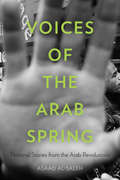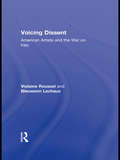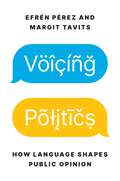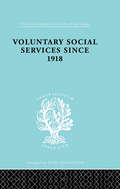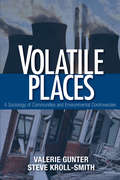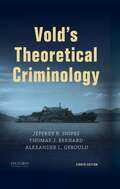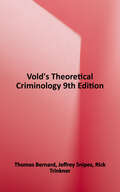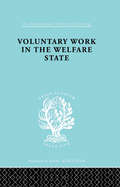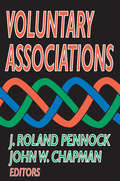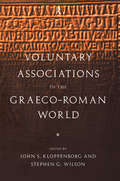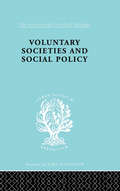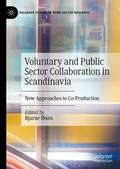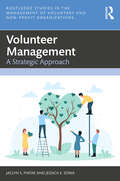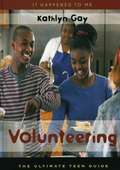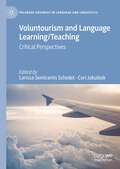- Table View
- List View
Voices of Freedom: A Documentary History, Volume 1 (3rd Edition)
by Eric FonerWritten as a companion to Foner's (history, Columbia U.) well-regarded American history survey textbook Give Me Liberty! this collection of 98 primary source documents reflects the fluid nature of definitions of freedom. Selections, some of which are excerpts, others reproduced in their entirety, span over 300 years of American history from the age of European exploration to Reconstruction. Organized chronologically, each document is preceded by a short introduction and followed by two study questions. Authors include Adam Smith, Noah Webster, Thomas Jefferson, fugitive slave Joseph Taper, Elizabeth Cady Stanton, Robert Owen, Pontiac, and James Winthrop among others. This third edition has a new global focus and contains more than 40 documents not featured in earlier editions. The work has not been indexed. Annotation ©2011 Book News, Inc., Portland, OR (booknews.com)
Voices of Freedom: A Documentary History, Volume 2 (3rd Edition)
by Eric FonerThe Third Edition of Voices of Freedom includes documents reflecting the global dimension of American history and remains a comprehensive collection that offers a diverse gathering of authors and a wide breadth of opinion.
Voices of Guatemalan Women in Los Angeles: Understanding Their Immigration (Latino Communities: Emerging Voices - Political, Social, Cultural and Legal Issues)
by Gabriele KohpahlFirst published in 1999. Guatemalan immigration is part of a trend where more women in an increasing number of countries than men participate in transnational migration. This research attempts to clarify the causes for this phenomenon. First, it evaluates which Guatemalan women initiators and pioneers in the decision to migrate. Second, it looks at women's diverse reasons for leaving Guatemala, and third, what are the conditions particular to women left behind? This study will also contribute to an understanding of the increasing diversification of the Latin American immigrant population in the United States.
Voices of Innovation - Payers: Opportunities for Creating Solutions to Improve Member Experience and Health
by Edward W. Marx Sakshika DhingraAs the health delivery landscape in the United States evolves in a post-COVID-19 era, both incumbents and new entrants are reimagining models of care. Technology and medical advancements are transforming the way care is delivered and experienced, and changes in regulations and incentives across the industry are redefining how the healthcare system works and interacts. As a result, care delivery is undergoing several transformations: from sick care to preventative whole-person care, from intermittent to continuous care, from facility-based settings to omnichannel offerings through virtual care and video or telephonic technologies, and from standardized to personalized solutions. In addition to healthcare providers, payers are also redefining their role in care delivery through provider ownership, technology, and provider enablement to deliver higher-value care to members. While the payer community has been slow to innovate, they now have an opportunity and an incentive to play an active role in reimagining the future of care delivery. In the past year alone, significant disruptors have entered the provider space threatening the existence of payers, specifically self-funded programs such as Amazon and Walmart. This has served as a giant wake-up call that healthcare has shifted. Now, more than ever, there is an emphasis on the patient and clinician experience. Perhaps hastened by the pandemic, the race is on for innovations from the payer community to improve patient and provider engagement. Unlike other players, payers have end-to-end visibility into individual care needs and utilization patterns across providers and settings. This perspective can provide informed choices around optimal care models, unlock value through improved health outcomes, and lower the total cost of care for members and customers. This book is loaded with numerous case studies and interviews with healthcare leaders from the payer community, helping stakeholders understand how to leverage innovation leading them to superior business and clinical outcomes. The book also discusses how and why data is key to innovation activities and how partnerships are key to using data effectively.
Voices of Intimate Partner Homicide: An Exploration of Coercive Control and Lethality
by Donna J. KingIn the United States and most parts of the world, law, policy, policing, and prevention work addressing domestic and intimate partner violence is created and enacted based on a violence model. Likewise, it is generally believed that all victims of intimate partner homicide are victims of intimate partner violence, through physical abuse, prior to the incident of homicide, and that this violence is reported beforehand.Voices of Intimate Partner Homicide takes a critical look at these misconceived notions and sheds light on multiple non-violent forms of controlling behavior that precipitate intimate partner homicide. The book bases its critical examination on a content analysis of court-filed Petitions for Injunction for Protection Against Domestic Violence. Through these records, as well as corresponding police and homicide reports, the accounts of the victims, and their relationships with their offenders, come to life. Recurring coercive control tactics are coded and analyzed across multiple accounts, including intimidation, isolation, and humiliation, to illustrate the ways in which individuals are threatened prior to homicide and the true extent of harm that happens in the absence of physical violence. Considering the victim’s responses, as well as their interaction with law enforcement and the court system prior to their death, the author challenges current legal and policy initiatives made to address and protect victims from intimate partner violence and argues that non-violent controlling behaviors deserve more attention in lethality risk assessments that are utilized throughout the United States.For practitioners, advocates, researchers, and students, this book provides an intimate and important account of the causes and consequences of intimate partner violence prior to homicide and a rare window into the victim’s overall experience.
Voices of Man: The Meaning and Function of Language (World Perspectives #8)
by Mario PeiOriginally published in 1964, this book examines where and how the pattern and texture of speech emerged and whether language is logical. It looks at linguistics from both the historical and descriptive points of view, as a physical science and as a social science. It also discusses the problem of aesthetics in language and what happens when different languages come into contact with each other. The book concludes with a discussion of the possibility of an international language, and indeed whether such a development would be progress or something that is needed or wanted.
Voices of South Asia: Essential Readings from Antiquity to the Present
by Patrick PeeblesAn ideal supplement for any course treating the history or culture of South Asia, this collection offers a cross-section of South Asia's ancient and modern classics of thought and expression. It includes a unique mix of poetry, novels, drama, and political and philosophical treatises, each accompanied by a detailed introductory essay on the specific historical context, the author, and the work.
Voices of Transgender Children in Early Childhood Education: Reflections on Resistance and Resiliency (Critical Cultural Studies of Childhood)
by Ashley L. Sullivan Laurie L. UrraroThis volume explores transgender children and internalized body normalization in early childhood education settings, steeped in critical methodologies including post-structuralism, queer theory, and feminist approaches. The book marries theory and praxis, submitting to current and future teachers a text that not only presents authentic narratives about trans children in early childhood education, but also analyzes the forces at work behind gender policing, gender segregation, and transphobic education policies. As the struggles and triumphs of trans individuals have reached a watershed moment in the social fabric of the United States, this text offers a snapshot into the lives of ten transgender people as they reflect on their earliest memories in the American educational system.
Voices of the Arab Spring: Personal Stories from the Arab Revolutions
by Asaad AlsalehNarrated by dozens of activists and everyday individuals, this book documents the unprecedented events that led to the collapse of dictatorial regimes in Tunisia, Egypt, Libya, and Yemen. Beginning in 2011, these stories offer unique access to the message that inspired citizens to act, their experiences during revolt, and the lessons they learned from some of the most dramatic changes and appalling events to occur in the history of the Arab world. The riveting, revealing, and sometimes heartbreaking stories in this volume also include voices from Syria. Featuring participants from a variety of social and educational backgrounds and political commitments, these personal stories of action represent the Arab Spring's united and broad social movements, collective identities, and youthful character. For years, the volume's participants lived under regimes that brutally suppressed free expression and protest. Their testimony speaks to the multifaceted emotional, psychological, and cultural factors that motivated citizens to join together to struggle against their oppressors.
Voices of the People in Nineteenth-Century France
by David HopkinThis innovative study of the lives of ordinary people – peasants, fishermen, textile workers – in nineteenth-century France demonstrates how folklore collections can be used to shed new light on the socially marginalized. David Hopkin explores the ways in which people used traditional genres such as stories, songs and riddles to highlight problems in their daily lives and give vent to their desires without undermining the two key institutions of their social world – the family and the community. The book addresses recognized problems in social history such as the division of power within the peasant family, the maintenance of communal bonds in competitive environments, and marriage strategies in unequal societies, showing how social and cultural history can be reconnected through the study of individual voices recorded by folklorists. Above all, it reveals how oral culture provided mechanisms for the poor to assert some control over their own destinies.
Voicing Dissent: American Artists and the War on Iraq (Routledge Studies in Law, Society and Popular Culture)
by Violaine Roussel Bleuwenn LechauxVoicing Dissent presents a unique and original series of interviews with American artists (including Guerrilla Girls on Tour, Tony Shalhoub, Shepard Fairey, Sean Astin, and many others) who have voiced their opposition to the war in Iraq. Following Pierre Bourdieu's example, these discussions are approached sociologically and provide a thorough analysis of the relationships between arts and politics as well as the limits and conditions of political speech and action. These painters and graphic artists, musicians, actors, playwrights, theatre directors and filmmakers reveal their perceptions of politics, war, security and terrorism issues, the Middle East, their experiences with activism, as well as their definition of the artist's role and their practice of citizenship. Addressing the crucial questions for contemporary democracies - such as artists' function in society, the crisis of political legitimacy and representation, the rise of new modes of contestation, and the limits to free public speech - this book will be of interest to scholars in sociology, politics, and the arts.
Voicing Politics: How Language Shapes Public Opinion (Princeton Studies in Political Behavior #45)
by Margit Tavits Efrén PérezWhy your political beliefs are influenced by the language you speakVoicing Politics brings together the latest findings from psychology and political science to reveal how the linguistic peculiarities of different languages can have meaningful consequences for political attitudes and beliefs around the world. Efrén Pérez and Margit Tavits demonstrate that different languages can make mental content more or less accessible and thereby shift political opinions and preferences in predictable directions. They rigorously test this hypothesis using carefully crafted experiments and rich cross-national survey data, showing how language shapes mass opinion in domains such as gender equality, LGBTQ rights, environmental conservation, ethnic relations, and candidate evaluations.Voicing Politics traces how these patterns emerge in polities spanning the globe, shedding essential light on how simple linguistic quirks can affect our political views. This incisive book calls on scholars of political behavior to take linguistic nuances more seriously and charts new directions for researchers across diverse fields. It explains how a stronger grasp of linguistic effects on political cognition can help us better understand how people form political attitudes and why political outcomes vary across nations and regions.
Vol Soc Serv Snce 1918 Ils 195: The Diaries Of Escher, Bodmer, May And De Gallois 1814-18 (International Library of Sociology)
by Henry MessFirst Published in 1998. Routledge is an imprint of Taylor & Francis, an informa company.
Volatile Places: A Sociology of Communities and Environmental Controversies
by Steve Kroll-Smith Valerie J. GunterVolatile Places: A Sociology of Communities and Environmental Controversies is a thoughtful guide to the spirited public controversies that inevitably occur when environments and human communities collide. The movie "An Inconvenient Truth" based on the environmental activism of Al Gore and the devastation of Hurricane Katrina are specifically highlighted. Authors Valerie Gunter and Steve Kroll-Smith begin with a simple observation and offer a provocative case study approach to the investigation of community and environmental controversies.
Vold's Theoretical Criminology
by Thomas J. Bernard Jeffrey B. Snipes Alexander L. GerouldThe standard text in the field, Vold's Theoretical Criminology is universally known by scholars in the discipline. Taking a largely historical approach, it discusses both classic and contemporary theories, presenting historical context, empirical research, and policy implications for each one. The book concludes with a critical assessment of the state of theory in criminology.
Vold's Theoretical Criminology
by Thomas J. Bernard Rick Trinkner Jeffrey B. SnipesThe standard text in the field, Vold's Theoretical Criminology is universally known by scholars in the discipline. Taking a largely historical approach, it discusses both classic and contemporary theories, presenting historical context and empirical research for each one. Vold's is a classic, trusted for decades as the definitive, comprehensive source of criminological theories. One of the marks of its success is that its usage spans introductory and upper-level courses, and even is used in graduate level courses. The writing style is crisp, clear, easy to understand but not watered down.
Volunt Work&Welf State Ils 197 (International Library of Sociology)
by Mary MorrisFirst Published in 1998. Routledge is an imprint of Taylor & Francis, an informa company.
Voluntary Associations (Nomos Ser. #No. Xi)
by John W. ChapmanA vast and complicated array of subject matter is subjected to analysis, comment, and speculation by fifteen contributors representing three separate but contiguous disciplines. Their approaches are as various as one would expect. One is concerned with the bonds that hold associations together, and another with the tendency for the private to become public. One sees associations as interferences with democratic political processes, while another is more impressed by their positive values. Still another shows that the way in which they operate in the political process depends not only on the kind of association but also upon the political context within which they operate.Pennock and Chapman say that the theorist's job is to speculate and to interpret the facts as he sees them. It is also the theorist's job to suggest hypotheses for testing: to point to lines of inquiry that should be pursued. One cannot read the essays in this volume, without having his eyes opened--or opened wider--both to the paucity of information about the political features of voluntary associations and to the wide variety of aspects from which the subject needs to be approached.The kinds of questions that need to be examined can be grouped in categories. The first focuses on the individual: What kinds of memberships does he have? Even more, what is the effect upon him of membership in each kind of association? The second examines internal composition and workings of organizations. The third focuses on the state as a whole and the effect of organized groups upon it, the political processes of the associational structure of the society, and modes of behavior of these associations.Organized groups play an intermediate role in the polity. At the same time, the state, and those charged at any particular time with the performance of its functions, must look primarily to new associations within it to secure compliance with its law and for guidance in shaping those laws.
Voluntary Associations in the Graeco-Roman World
by John S. Kloppenborg Stephen G. WilsonBased upon a series of detailed case studies of associations such as early synagogues and churches, philosophical schools and pagan mystery cults, this collection addresses the question of what can legitimately be termed a 'voluntary association'.Employing modern sociological concepts, the essays show how the various associations were constituted, the extent of their membership, why people joined them and what they contributed to the social fabric of urban life. For many, those groups were the most significant feature of social life beyond family and work. All of them provided an outlet of religious as well as social commitments.Also included are studies of the way in which early Jewish and Christian groups adopted and adapted the models of private association available to them and how this affected their social status and role. Finally, the situation of women is discussed, as some of the voluntary associations offered them a more significant recognition than they received in society at large.
Voluntary Societies and Social Policy (International Library of Sociology #Vol. 196)
by Madeline RooffFirst Published in 1998. Routledge is an imprint of Taylor & Francis, an informa company.
Voluntary and Public Sector Collaboration in Scandinavia: New Approaches to Co-Production (Palgrave Studies in Third Sector Research)
by Bjarne IbsenIn thirteen chapters, the contributors to this volume analyse the different dimensions of a new form of collaboration, termed collective co-production, in the Scandinavian countries. It is a characteristic of the Scandinavian countries – Sweden, Norway and Denmark - that they have both a large public and voluntary sector. For decades, the dominant type of collaboration between the two sectors has consisted of the public sector providing financial support to organisations in the voluntary sector, while the activities are undertaken by the organisation itself. In recent times, however, a new discourse has emerged, with a strong political focus on developing closer collaboration between the two sectors. The book analyses collective co-production between the voluntary and public sectors, and identifies what distinguishes this form of collaboration from others. It looks at the scope of collective co-production, how and why it differs between welfare areas, as well as the political vision for co-production and the extent to which it lives up to those expectations. This discourse promotes a type of collaboration wherein organisations, associations and volunteers can participate in the implementation of tasks for which public institutions are responsible. The book is a valuable resource for professionals in voluntary organizations and public welfare units working with co-production and for researchers and students in the fields of civil society, voluntary sector and welfare policy.
Volunteer Management: A Strategic Approach (Routledge Studies in the Management of Voluntary and Non-Profit Organizations)
by Jessica E. Sowa Jaclyn S. PiatakVolunteers play a critical role in serving communities and delivering public services. Volunteers serve across many areas — in schools, human service organizations, emergency services, and more. By providing services to those in need, volunteers expand the capacity of organizations and can devote extra time to the populations they serve. While research on volunteering has shifted from a focus on recruitment and motivation to management and retention, the focus is largely on universal, one-size-fits-all prescriptions. Volunteer management only recently moved to a contingency perspective focused on organizational needs. However, volunteer management should adapt to meet the needs of organizations and volunteers.Taking a strategic approach, this book provides an overview of volunteer management from planning and recruitment to engagement and evaluation, considering both organizational and volunteer needs and capacity. We develop a strategic volunteer management approach for volunteering to benefit not only the organizations and communities served, but also volunteers and society more broadly.This book advances research on volunteer management by combining the organizational and volunteer perspectives, provides a guide for volunteer administrators and coordinators, and serves well as a text for courses in volunteer management, nonprofit management, and human resource management.
Volunteering: The Ultimate Teen Guide
by Kathlyn GayWritten for teenagers, her resource text explores the world of volunteering in the U.S., including an overview of what volunteering is, the range of opportunities that are available, the benefits of participating, and how to get started. Also included is a list of selected resource organizations to contact; each entry includes the organization's name, address, website, and brief description of its focus. For teens and those who work with teens. Annotation ©2004 Book News, Inc., Portland, OR (booknews.com)
Voluntourism and Language Learning/Teaching: Critical Perspectives (Palgrave Advances in Language and Linguistics)
by Larissa Semiramis Schedel Cori JakubiakThis edited volume extends current voluntourism theorizing by critically examining the intersections among various forms of work-leisure travel and language learning/teaching. The book’s contributors investigate volunteer tourism and its cognates such as working holidaymaking, international internships, and gap year labor, as discursive fields in which powerful ideas about language(s), their speakers, and pedagogical practices are propagated worldwide. The various authors’ chapters shed light on the hegemony of global English, the social consequences of linguistic commodification and neoliberal rationalities, the ways in which speaker identity positions can alter the exchange value of languages, and how language competencies are tied to power in the labor market, among related topics. This volume will be of interest to readers in Applied Linguistics, Critical Sociolinguistics, Educational and Linguistic Anthropology, Tourism and Leisure Studies, Migration and Mobility Studies, and Language Teaching and Learning.
